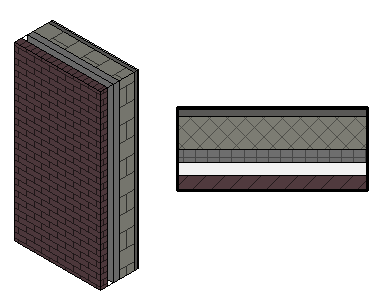Each layer in a compound structure is assigned a material.

For example, one layer might be the air infiltration barrier, another is plywood, followed by a layer of wood. Revit has several predefined materials, or you can create your own using the Materials tool.
The materials in a compound element can be tagged, scheduled, and included in material takeoffs.
When the Detail Level of the view is set to Medium or Fine, the layers of the compound element display according to the material properties of the layers. At a Coarse level of detail, the layers of the compound structure are not displayed. Instead, only the boundary of the element displays, along with the Coarse Scale Fill Pattern and Course Scale Fill Color, if these type properties are specified for the compound structure.
Properties of the thermal assets for materials and the thickness of the layers are used to calculated the R-value of the compound structure. The R-value is used in creating the energy analytical model.